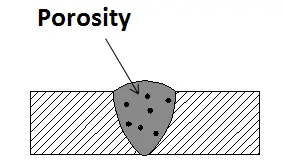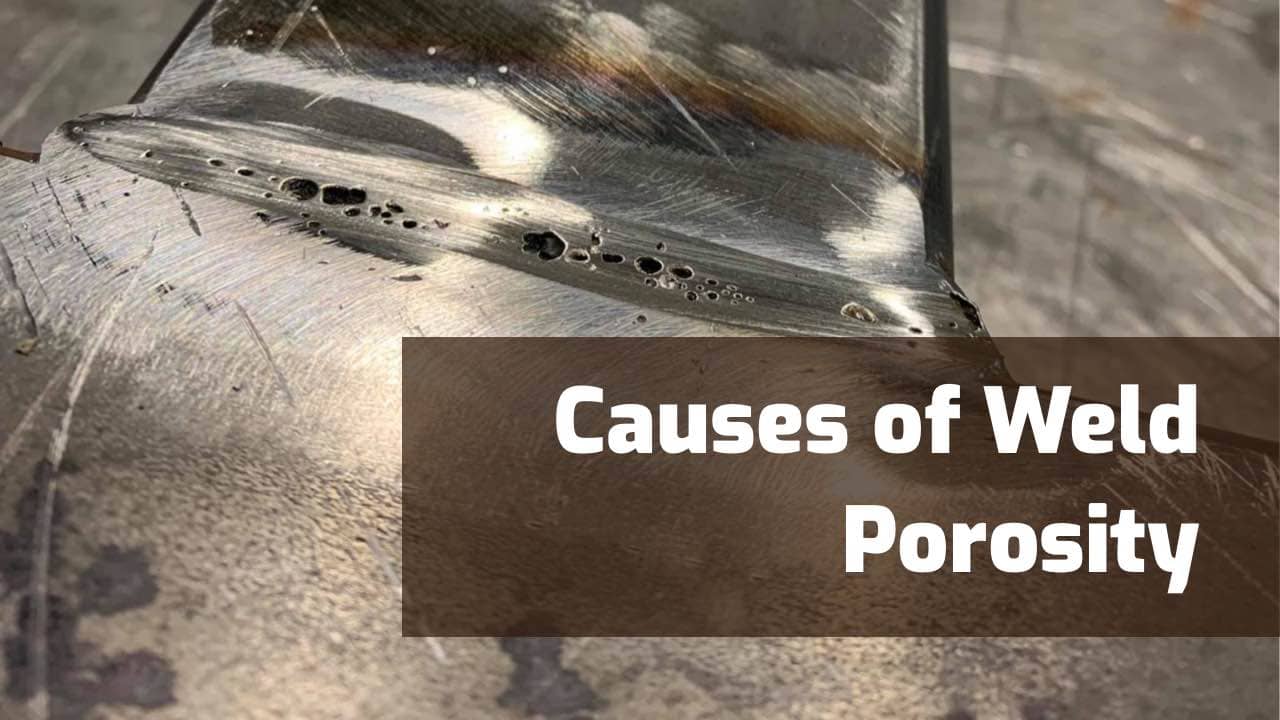Welding porosity is a common welding defect that occurs when gas bubbles are trapped in the weld metal during solidification. Welding porosity can affect the appearance, strength, and corrosion resistance of the weld, and can lead to weld failure or rejection. Therefore, it is important to understand what is porosity in welding, what causes it, what types of porosity exist, how to prevent it, and how to fix it.

I. What is Welding Porosity?
Welding porosity is the presence of gas pockets or pores in the weld metal. These pores can be visible on the surface of the weld or hidden inside the weld bead. Porosity defects can occur in any welding process, but it is more common in gas-shielded processes such as MIG and TIG welding.
Porosity can reduce the effective cross-sectional area of the weld, which can lower its tensile strength, fatigue strength, and impact toughness. Porosity can also create stress concentrations and crack initiation sites, which can lead to premature fracture. Moreover, porosity problems can impair the aesthetic quality of the weld and increase its susceptibility to corrosion and hydrogen embrittlement.
II. What Causes Porous Welds?
Welding porosity is caused by the entrapment of gas in the molten weld pool. The gas can come from various sources, such as:

Contamination of the base metal or the filler metal: Dirt, oil, grease, paint, rust, moisture, or other impurities can introduce gas into the weld pool or interfere with the shielding gas. These contaminants can also react with the weld metal and form oxides or other compounds that can create porosity.
Improper shielding gas or flux: The shielding gas or flux is used to protect the weld pool from atmospheric contamination and oxidation. However, if the shielding gas or flux is not suitable for the welding process or the material, it can cause porosity. For example, using a shielding gas with too much oxygen or carbon dioxide can cause oxidation of the weld metal and form carbon monoxide or carbon dioxide bubbles. Similarly, using a flux with too much moisture or hydrogen can cause hydrogen embrittlement or hydrogen cracking in the weld metal.
Incorrect welding parameters or technique: The welding parameters or technique can affect the heat input, the arc stability, the penetration, and the deposition rate of the weld metal. If these factors are not optimized for the welding process or the material, they can cause porosity. For example, using too high or too low current or voltage can cause excessive spatter or insufficient fusion. Likewise, using too long or too short arc length can cause arc blow or lack of shielding. Moreover, using too fast or too slow travel speed can cause overheating or underfilling of the weld pool.
Poor electrode condition or storage: The electrode is the source of filler metal and sometimes shielding gas for the weld pool. Therefore, the electrode condition or storage can affect the quality of the weld metal and cause porosity. For example, using a dampened or contaminated electrode can introduce moisture or impurities into the weld pool. Similarly, using an incorrect electrode size or type can cause mismatched properties or composition of the weld metal.
III. What Types of Porous Welds Exist?
Four main types of welding porosity can occur in different forms and locations:
Surface porosity: This type of porosity appears as small holes on the surface of the weld bead. It is usually caused by contamination on the base metal or filler metal that vaporizes during welding and forms gas bubbles that rise to the surface of the weld pool. Surface porosity is easy to detect by visual inspection.
Subsurface porosity: This type of porosity occurs inside the weld bead and is not visible on the surface. It is usually caused by shielding gas problems that allow atmospheric air to enter the weld pool and form gases that are trapped in the molten metal during solidification. Subsurface porosity is difficult to detect by visual inspection and requires non-destructive testing methods such as radiography or ultrasonography.
Wormhole porosity: This type of porosity consists of elongated pores that resemble wormholes. It is usually caused by welding technique problems that create arc instability or incomplete fusion and result in large amounts of gas being trapped along the weld axis. Wormhole porosity is often associated with flux-cored arc welding (FCAW) or submerged arc welding (SAW) processes that use flux to protect the weld pool from atmospheric contamination. Wormhole porosity is revealed when the slag is removed from the weld bead.
Crater porosity: This type of porosity occurs at the end of the weld bead and forms a small depression or crater. It is usually caused by welding machine problems that affect the termination of the arc or by improper crater-filling technique. Crater porosity is caused by gas escaping from the molten metal as it cools and shrinks at the end of the weld.
IV. What are the Effects of Porosity in Welding?
Welding porosity can have negative effects on the weld quality and performance, such as:
Reduced strength and ductility: The presence of gas bubbles in the weld metal can reduce its cross-sectional area and create stress concentration points. This can lower its tensile strength and ductility, and make it more prone to cracking or breaking under load.
Increased corrosion susceptibility: The gas bubbles in the weld metal can create crevices or pits that can trap moisture or corrosive agents. This can increase its corrosion susceptibility and accelerate its degradation over time.
Impaired appearance and inspection: The gas bubbles in the weld metal can impair its appearance and make it look rough or uneven. This can affect its aesthetic value and customer satisfaction. Moreover, the gas bubbles in the weld metal can interfere with its inspection and testing methods. For example, they can obscure defects such as cracks or inclusions during radiographic testing.
V. How to Prevent Porosity in Welding?
Welding porosity can be prevented by following some best practices before, during, and after welding, such as:
Clean the base metal and filler metal before welding to remove any contamination that could vaporize and form gas bubbles in the weld pool. Use a wire brush, a grinder, a solvent, or a degreaser to remove any oil, grease, paint, rust, mill scale, moisture, or dirt from the surfaces to be welded.
Use a suitable shielding gas for your welding process and application. Choose a gas mixture that matches your base metal and filler metal composition and provides adequate protection from atmospheric contamination. Check your gas flow rate, pressure, and hose connections for any leaks or blockages. Avoid welding in windy or drafty conditions that could disrupt your shielding gas coverage.
Adjust your welding technique to avoid excessive spatter, arc instability, or incomplete fusion. Maintain a proper arc length, travel speed, electrode angle, and torch manipulation to ensure a smooth and consistent weld pool. Avoid excessive weaving or oscillation that could trap gas in the weld pool. Use a backstep or backfill technique to fill the crater at the end of the weld and prevent crater porosity.
Set your welding machine parameters according to the manufacturer’s recommendations and your welding process and application. Choose the correct voltage, current, polarity, and wire feed speed for your base metal and filler metal thickness and type. Use a suitable transfer mode for your filler metal and shielding gas, such as short-circuit, globular, spray, or pulsed transfer.
Inspect your welds for any signs of porosity and perform non-destructive testing if necessary. If you find any porosity in your welds, identify the cause and correct it before proceeding with the welding. If the porosity is severe or unacceptable for your application, you may need to remove the defective weld and re-weld it.
VI. How to Fix Welding Porosity Defect?
If you already have welding porosity in your welds, you need to fix them as soon as possible to restore their quality and performance. Here are some steps you can follow to fix welding porosity:
Locate and mark the porosity: You need to locate and mark the porosity in your weld using visual inspection or other methods. You should identify the size, shape, depth, and location of the porosity in your weld.
Remove the porosity: You need to remove the porosity from your weld using a grinding wheel, a chisel, a drill, or a gouging torch. You should create a smooth cavity that is slightly larger than the original porosity.
Clean and prepare the cavity: You need to clean and prepare the cavity using a wire brush or a solvent to remove any slag, spatter, oxide, or impurities. You should also preheat the cavity if necessary to reduce thermal stress and cracking.
Fill the cavity with filler metal: You need to use a suitable filler metal and welding technique to fill the cavity with multiple passes. You should start from one end of the cavity and work your way to the other end, making sure each pass overlaps with the previous one. You should also control your heat input and speed to avoid creating new porosity.
Finish and inspect the weld: You need to smooth out any rough edges or irregularities using a grinding wheel or a file. You should also clean any slag or spatter using a wire brush or a chipping hammer. Finally, you should inspect your weld using visual, mechanical, or non-destructive methods to ensure it is free of porosity and other defects.
Welding porosity is a common welding defect that can affect the quality and performance of your welds. It is caused by gas bubbles being trapped in the weld metal during solidification. Porosity can occur in different types and locations, depending on the source of the gas and the welding process. Porosity can be prevented by following some general guidelines and best practices, such as cleaning the base metal and filler metal, using a suitable shielding gas, adjusting your welding technique, setting your welding machine parameters, and inspecting your welds. By avoiding welding porosity, you can ensure a strong, durable, and reliable weld.
Related article:
1. Undercut Welding Defect: Causes, Prevention, and Repair
2. When Light Poses Risks in Welding: Dangers and Solutions
3. Welding Defects, Problems And Easy Solutions [2023]
4. Solutions to 10 Common TIG Welding Problems
5. Robotic Welding & Complete Automation Solutions





